
Countersink vs. Counterbore Hole Diagram
If you’re aiming for precision, durability, and sleek aesthetics in your product design, countersunk holes are a non-negotiable requirement. These specialized holes enable fasteners to sit flush with the material surface, resulting in cleaner and safer components, particularly in high-performance applications.
But not all countersunk holes are created equal. Understanding the correct dimensions, purpose, and machining process can drastically improve the quality of your final product and reduce your manufacturing costs.
At ProleanTech, we specialize in CNC machining solutions that deliver flawless countersunk holes tailored to your exact specs. With a proven track record serving clients across industries, our team ensures tight tolerances, optimal finishes, and efficient production — even for the most complex hole geometries.
Stick around to learn what countersunk holes are, their dimensions, and their uses and applications. So, let’s get into the topic.
Understanding Countersunk Hole Callouts
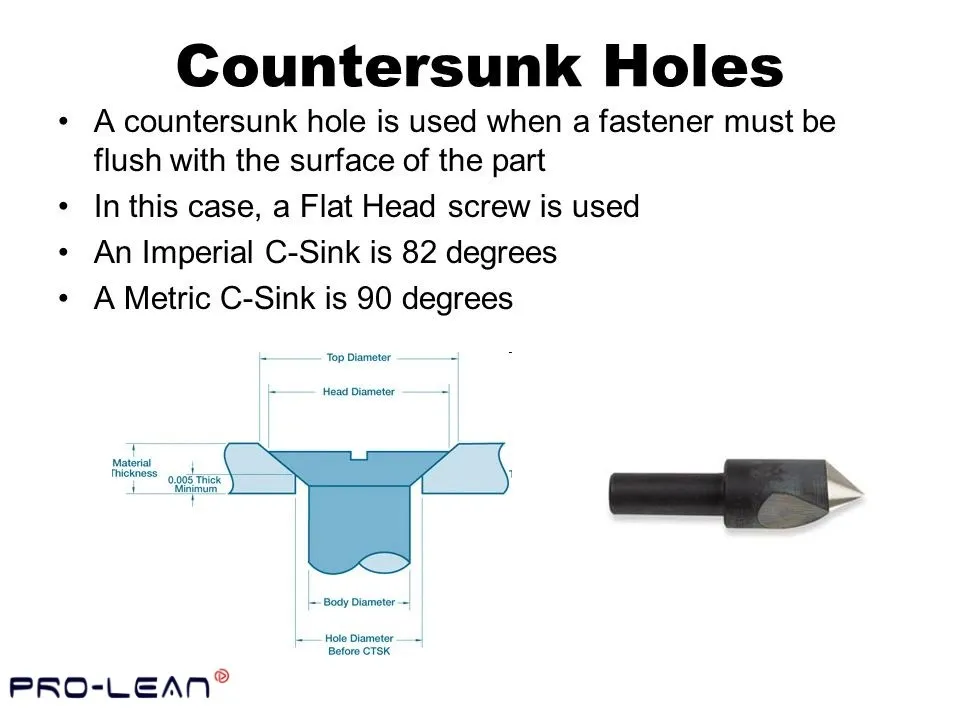
Countersunk Hole Explanation and Tool
There are different types of holes in engineering, each with its unique applications. A countersink hole is a conical hole or depression in a material, typically around the edge of a hole. The “conical” feature is what differentiates a countersunk hole from a counterbore.
The ISO callout for a countersink is: ⌵. The countersink is sized according to the head dimensions of the fitted fastener, ensuring that a flat-faced fastener sits flush with the countersunk surface.
So the three things that make up the definition of a countersunk hole are:
- Countersunk diameter
- Countersunk dimension
- Pilot hole diameter
Try Prolean Now!
Dimension Countersunk Holes for Precision
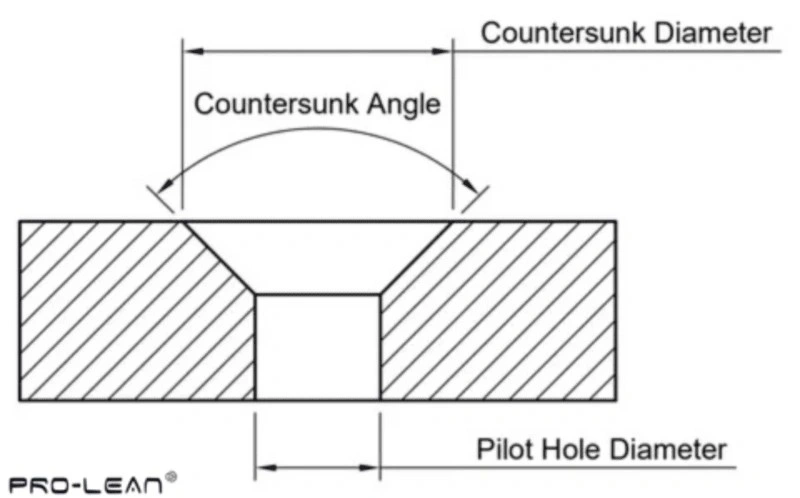
Countersunk Hole Dimensions Diagram
Countersunk holes are necessary in manufacturing and machining as they allow screws to sit with a smooth surface. This gives a neat final look. However, dimensioning these holes is essential for structural integrity. The key dimensions of hole drilling ADM you must keep in mind for precision are:
- Hole diameter is the central hole drilled to accommodate the screw’s threaded body.
- Countersink diameter is the larger, conical recess at the top of the hole, which allows the screw head to sit flush. This should be slightly larger than the screw head diameter.
- The countersink angle is the angle of the conical recess. It is typically 60°, 90°, and 120°.
- Countersink depth is the depth of the countersunk portion, ensuring the screw sits flush or slightly below the surface.
Now that we know what a countersunk hole is and the key dimensions of a countersunk hole, let’s find the key differences between Countersink vs. Counterbore.
Countersink vs Counterbore: Key Differences
Here are the key differences between countersink and counterbore:
| Feature | Countersink | Counterbore |
| What It Is | A cone-shaped hole that lets a screw sit flush or below the surface. | A flat-bottomed hole that makes space for a bolt or screw head. |
| Shape | Conical (angled) | Cylindrical (flat-bottomed) |
| Angle | Usually 82°, 90°, 100°, or 120°. | No angle, just a straight hole with a flat bottom. |
| Purpose | Helps screws sit smoothly so they don’t stick out. | Provides space for bolt heads to prevent them from sticking out. |
| Where It’s Used | Woodworking, metalworking, aerospace, and general construction. | Used in machines, cars, and industrial equipment. |
| Drilling Tools | Countersink bit or a combo drill/countersink bit. | Counterbore bit or an end mill cutter. |
| Works With | Wood, plastic, soft metals, and composites. | Metal, plastic, and certain types of wood. |
| How It Looks | A sloped, cone-like indentation. | A round, deep hole with a flat bottom. |
| Best for These Screws | Flathead screws (wood screws, machine screws). | Hex bolts, socket head screws, and other large fasteners. |
| Precision Needed | The angle must match the screw for a good fit. | The depth and diameter must fit the bolt head properly. |
| Strength Effect | It can weaken thin materials because it removes material at an angle. | A stronger hold is achieved since the fastener sits deeper in the material. |
Compare Counterbore vs. Spotface for a thorough understanding.
Standard Sizes of Countersunk Holes
You cannot just drill a hole in metal. There is a standard for countersunk hole sizes, depending on the type of fastener and its intended purpose. The standard angles include 60°, 90°, and 120°. Here are the standard sizes of countersunk holes:
| Countersink Angle (θ) | Screw Head Type | Countersink Diameter (D₁) | Recommended Hole Diameter (D) | Fastener Size |
| 90° | Flathead Screws | 1.5 × Screw Head Diameter | Same as screw body diameter | Common Machine Screws |
| 100° | Flathead Screws | 1.6 × Screw Head Diameter | Same as screw body diameter | Larger Screws |
| 120° | For larger bolts | 1.7 × Screw Head Diameter | Same as screw body diameter | Heavy-Duty Bolts |
| 60° | For specialized fasteners | 1.3 × Screw Head Diameter | Same as screw body diameter | Precision or Small Screws |
Deburring at 60°
This countersink angle is mainly used to clean the screw area of a metal part of burrs or sharp edges. The metal’s edges are smoother after deburring.
Rivet Heads at 75°
This angle is suitable for the majority of rivet head types, including drive, flush, friction-lock, Oscar, self-piercing, structural steel, and solid rivets.
Countersunk Screw at 82° and 90°
Countersunk screws come in two different angles. However, the industry countersink screw standard determines the precise angle that is selected. For example, some nations and areas use 90° countersunk screws and the same angles, but the US standard is 82°.
Countersink Sheet Metal Rivets at 120°
The thinner and blind rivets frequently use a countersinking angle of 120°. This is because they’re used for connecting sheet metals.
Try Prolean Now!
Custom CNC Machining for Complex Countersunk Holes

CNC Precision: Custom Countersunk Holes
Countersinking, in general, is a secondary operation after the hole formation. For this, there are multiple tools with different cutting faces to meet the requirements of various hole sizes. For example, the drills have a single cutter for larger countersinks, allowing for an even cut.
Unlike manual methods, customized CNC machining makes complex designs simple and creates them with perfect angles. Custom CNC machining for countersunk holes offers accurate sizing, which is particularly useful when using complex fasteners.
Moreover, CNC machining offers greater flexibility in terms of hole size, depth, and angles. CNC machining is a perfect solution for complex countersunk holes because it’s a one-time process. Once the design is set up, you can make batch holes without lifting your finger.
With CNC hole drilling, there is little to no waste produced, thereby minimizing the overall cost of the production process.
Custom Metal Machining Solutions for Industrial Applications
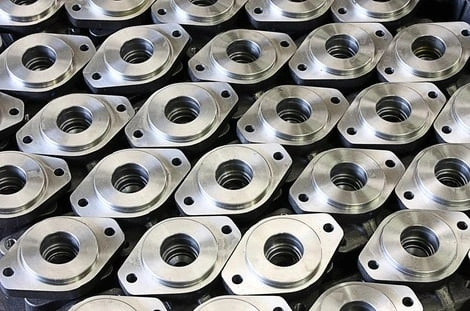
Precision Metal Machining for Industry
Precision machining is crucial when creating countersunk holes, particularly in high-performance industries such as aerospace. One of the challenges is maintaining extremely tight tolerances to ensure proper fastener seating and structural integrity. For example, in a satellite bracket made of titanium, achieving a 0.02 mm depth tolerance is necessary to meet safety and performance standards.
CNC drilling plays a crucial role. For example, Carbide countersinks with PVD (Physical Vapor Deposition) coating are used to reduce heat buildup and extend tool life. This is particularly important when machining hard metals, such as titanium.
In addition to tooling, custom metal machining provides process optimization to ensure superior countersunk hole quality. Adaptive CNC toolpaths are programmed to minimize burr formation, reducing the need for post-machining finishing. This improves efficiency and provides a smoother, more precise hole geometry.
When dealing with metals, quality is a critical aspect that cannot be compromised. Laser scanning technology is used for depth verification, which is necessary to prevent costly errors from occurring.
Due to machining innovations, compliance with AS9100 aerospace standards reached 99.5%, demonstrating the effectiveness of high-precision countersinking techniques. Manufacturers can produce high-strength countersunk holes that meet the strictest industry requirements.
Final Words
Precision countersunk holes are essential for creating smooth surfaces and robust connections in our products. At ProleanTech, we create perfect countersunk holes with tolerances as tight as 0.02 mm using our advanced CNC machines for various industries.
Our aerospace clients trust us to meet industry standards with 99.5% compliance. Our automotive clients appreciate how our processes produce clean holes with smooth edges. Medical device makers rely on our PVD-coated carbide tooling for exceptional finish quality in titanium components.
Trust ProleanTech because we work with all types of materials and identify problems before they occur with our advanced laser scanning technology. This means you’ll save money by avoiding mistakes, finish projects faster, and create products that last longer.
Don’t compromise on critical features, such as countersunk holes, that affect both form and function. Get in touch with us today and discover how our custom CNC machining services can solve your manufacturing challenges.
FAQs
1. What is a countersunk hole?
A countersunk hole is the enlarged upper part of a hole cut into a manufactured object or the cutter used to cut such a hole.
2. What is the purpose of a countersunk?
A countersunk hole is drilled so that head of screw can sunk below the surface. This gives a smooth finish to the metal surface.
3. What is the difference between a countersink and a countersunk?
Countersink or countersunk hole are used interchangeably. However, a countersink is also a tool to cut the hole. To differentiate between the two, a countersunk hole refers to the hole itself, while a countersink is a tool used to create that hole.
4. How do I specify a countersunk hole in an engineering drawing?
The callout symbol for a countersink hole is ‘⌵’. Countersunk holes are used in engineering when a countersunk bolt or screw is required.
5. What’s the maximum depth tolerance achievable in CNC-machined countersinks?
Depending upon the size and dimensions, you can calculate the tolerance using this formula:
tolerance (t) = upper limit – lower limit
6. Why choose countersinks over counterbores for thin sheets?
Countersinks remove less material, therefore maintaining the material’s strength. On the other hand, counterbores require more depth, which weakens the thin sheets.
7. How to prevent tool breakage when machining hardened steel countersinks?
To prevent tool breakage, use sharp tools with adequate speed and feed. Moreover, lubricants should be used, and the depth should be gradually increased to avoid damage.


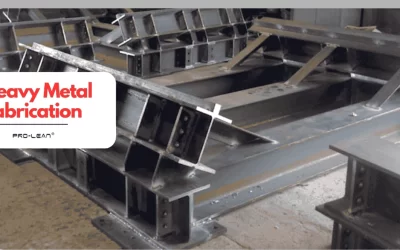
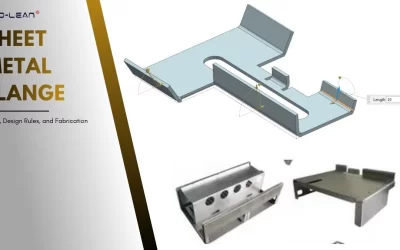
0 Comments